Digital Transformation Strategies and Future Recommendations for Lidl
VerifiedAdded on 2022/12/29
|7
|1971
|95
Report
AI Summary
This report provides a comprehensive analysis of Lidl's digital transformation journey. It begins with an overview of Lidl's digital history, highlighting its evolution from traditional brick-and-mortar stores to embracing e-commerce and digital technologies. The main body delves into Lidl's digital transformation strategies, including the launch of e-commerce platforms, mobile apps, and payment systems, and evaluates their impacts on the business. A competitive analysis examines Lidl's position relative to competitors like Aldi and Tesco, assessing their digital strategies and the intensity of competition. The report then offers recommendations for future technologies, such as in-store kiosks and electronic price tags, to enhance customer experience and maintain a competitive edge. The report concludes by summarizing the key findings and emphasizing the importance of digital adaptation for continued success in the retail industry. The report draws upon various sources, including journal articles and online resources, to support its analysis.
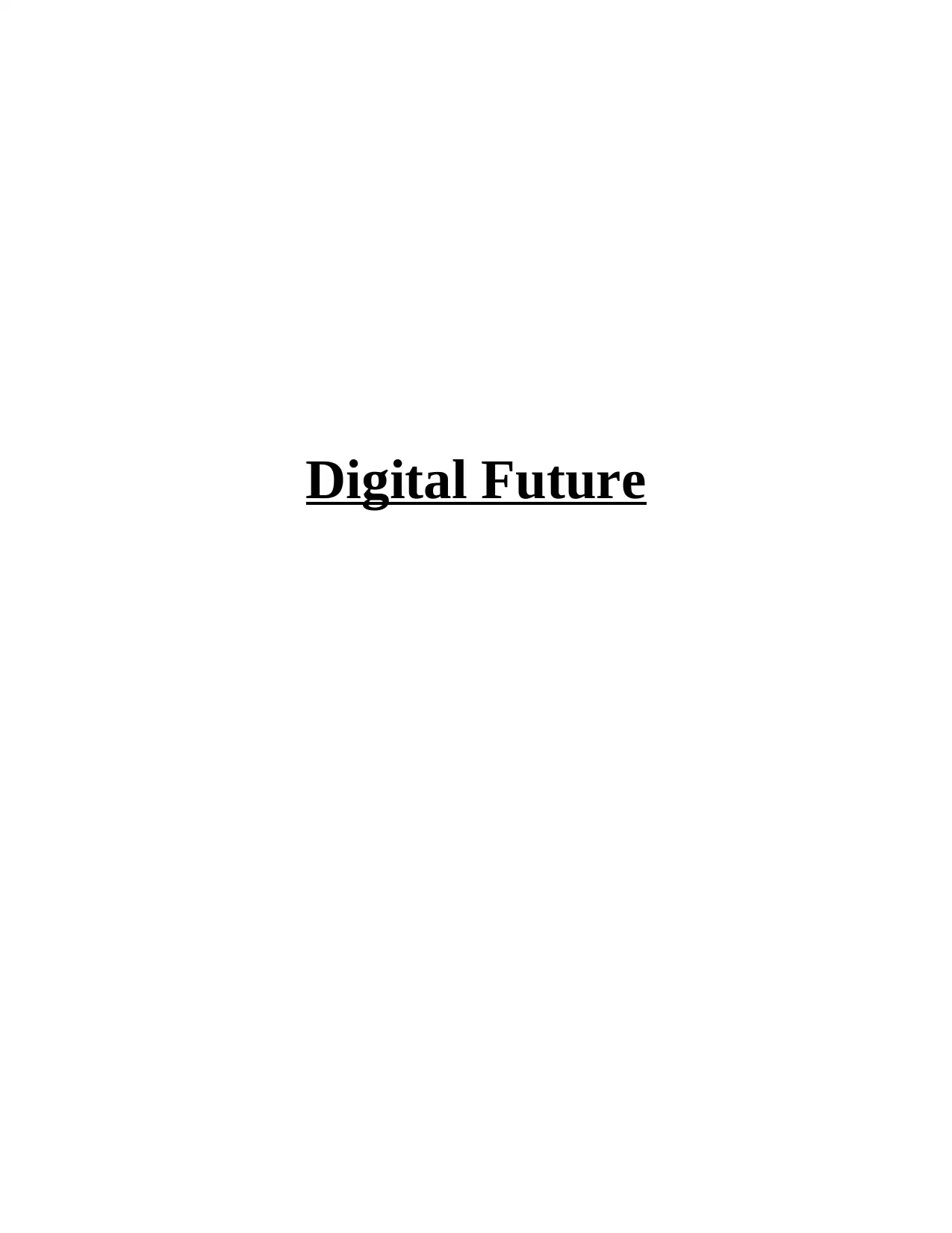
Digital Future
Paraphrase This Document
Need a fresh take? Get an instant paraphrase of this document with our AI Paraphraser
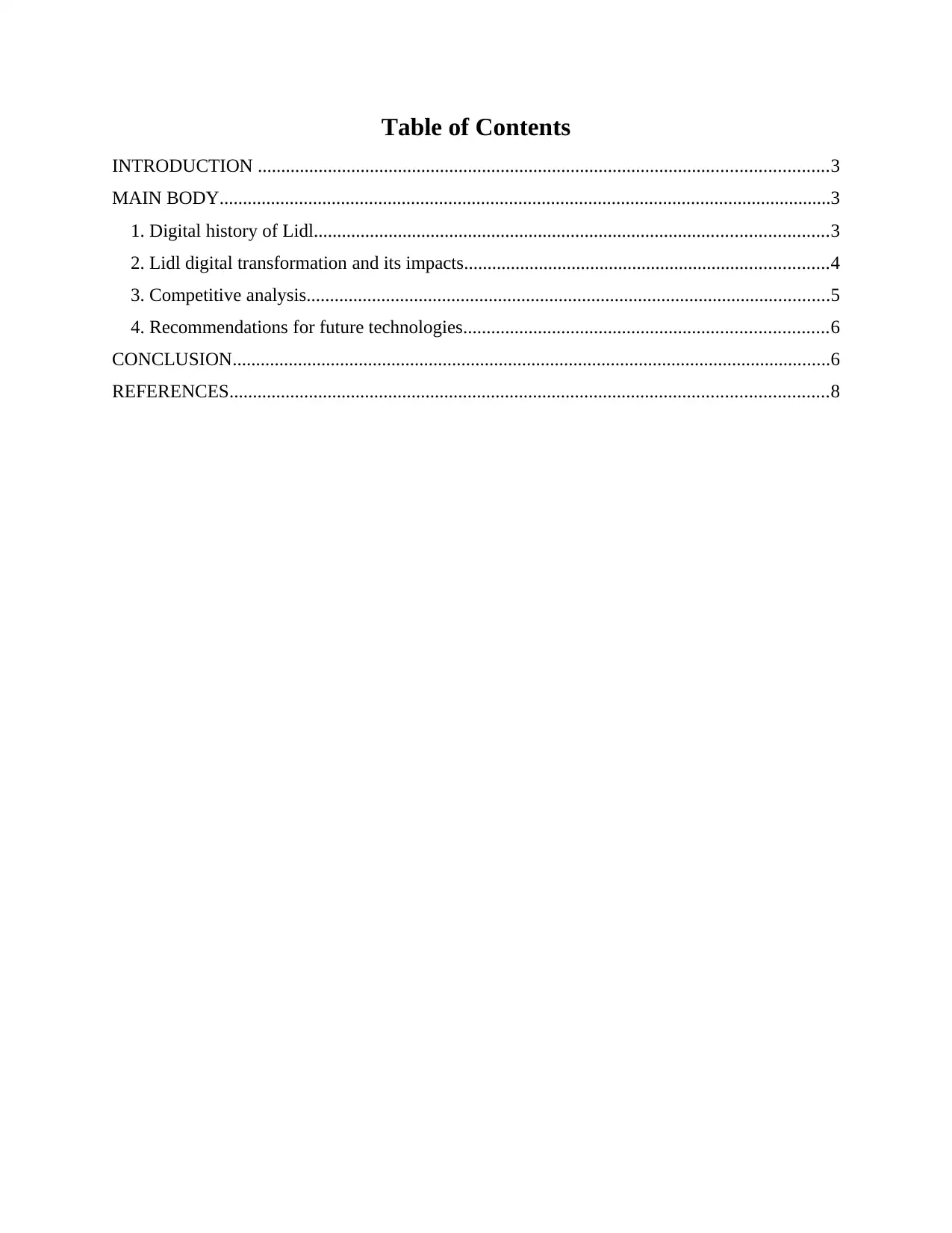
Table of Contents
INTRODUCTION ..........................................................................................................................3
MAIN BODY...................................................................................................................................3
1. Digital history of Lidl..............................................................................................................3
2. Lidl digital transformation and its impacts..............................................................................4
3. Competitive analysis................................................................................................................5
4. Recommendations for future technologies..............................................................................6
CONCLUSION................................................................................................................................6
REFERENCES................................................................................................................................8
INTRODUCTION ..........................................................................................................................3
MAIN BODY...................................................................................................................................3
1. Digital history of Lidl..............................................................................................................3
2. Lidl digital transformation and its impacts..............................................................................4
3. Competitive analysis................................................................................................................5
4. Recommendations for future technologies..............................................................................6
CONCLUSION................................................................................................................................6
REFERENCES................................................................................................................................8
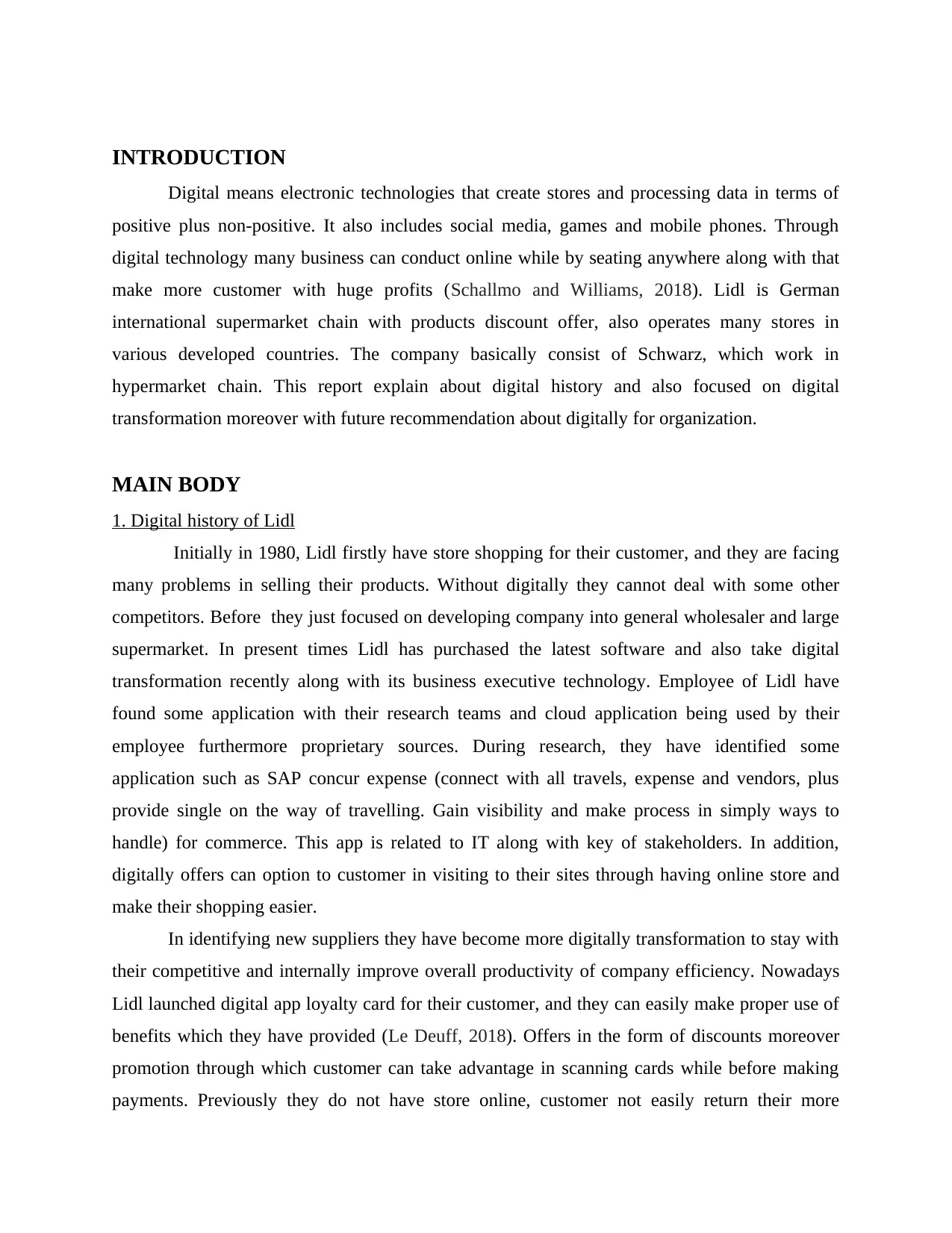
INTRODUCTION
Digital means electronic technologies that create stores and processing data in terms of
positive plus non-positive. It also includes social media, games and mobile phones. Through
digital technology many business can conduct online while by seating anywhere along with that
make more customer with huge profits (Schallmo and Williams, 2018). Lidl is German
international supermarket chain with products discount offer, also operates many stores in
various developed countries. The company basically consist of Schwarz, which work in
hypermarket chain. This report explain about digital history and also focused on digital
transformation moreover with future recommendation about digitally for organization.
MAIN BODY
1. Digital history of Lidl
Initially in 1980, Lidl firstly have store shopping for their customer, and they are facing
many problems in selling their products. Without digitally they cannot deal with some other
competitors. Before they just focused on developing company into general wholesaler and large
supermarket. In present times Lidl has purchased the latest software and also take digital
transformation recently along with its business executive technology. Employee of Lidl have
found some application with their research teams and cloud application being used by their
employee furthermore proprietary sources. During research, they have identified some
application such as SAP concur expense (connect with all travels, expense and vendors, plus
provide single on the way of travelling. Gain visibility and make process in simply ways to
handle) for commerce. This app is related to IT along with key of stakeholders. In addition,
digitally offers can option to customer in visiting to their sites through having online store and
make their shopping easier.
In identifying new suppliers they have become more digitally transformation to stay with
their competitive and internally improve overall productivity of company efficiency. Nowadays
Lidl launched digital app loyalty card for their customer, and they can easily make proper use of
benefits which they have provided (Le Deuff, 2018). Offers in the form of discounts moreover
promotion through which customer can take advantage in scanning cards while before making
payments. Previously they do not have store online, customer not easily return their more
Digital means electronic technologies that create stores and processing data in terms of
positive plus non-positive. It also includes social media, games and mobile phones. Through
digital technology many business can conduct online while by seating anywhere along with that
make more customer with huge profits (Schallmo and Williams, 2018). Lidl is German
international supermarket chain with products discount offer, also operates many stores in
various developed countries. The company basically consist of Schwarz, which work in
hypermarket chain. This report explain about digital history and also focused on digital
transformation moreover with future recommendation about digitally for organization.
MAIN BODY
1. Digital history of Lidl
Initially in 1980, Lidl firstly have store shopping for their customer, and they are facing
many problems in selling their products. Without digitally they cannot deal with some other
competitors. Before they just focused on developing company into general wholesaler and large
supermarket. In present times Lidl has purchased the latest software and also take digital
transformation recently along with its business executive technology. Employee of Lidl have
found some application with their research teams and cloud application being used by their
employee furthermore proprietary sources. During research, they have identified some
application such as SAP concur expense (connect with all travels, expense and vendors, plus
provide single on the way of travelling. Gain visibility and make process in simply ways to
handle) for commerce. This app is related to IT along with key of stakeholders. In addition,
digitally offers can option to customer in visiting to their sites through having online store and
make their shopping easier.
In identifying new suppliers they have become more digitally transformation to stay with
their competitive and internally improve overall productivity of company efficiency. Nowadays
Lidl launched digital app loyalty card for their customer, and they can easily make proper use of
benefits which they have provided (Le Deuff, 2018). Offers in the form of discounts moreover
promotion through which customer can take advantage in scanning cards while before making
payments. Previously they do not have store online, customer not easily return their more
⊘ This is a preview!⊘
Do you want full access?
Subscribe today to unlock all pages.

Trusted by 1+ million students worldwide
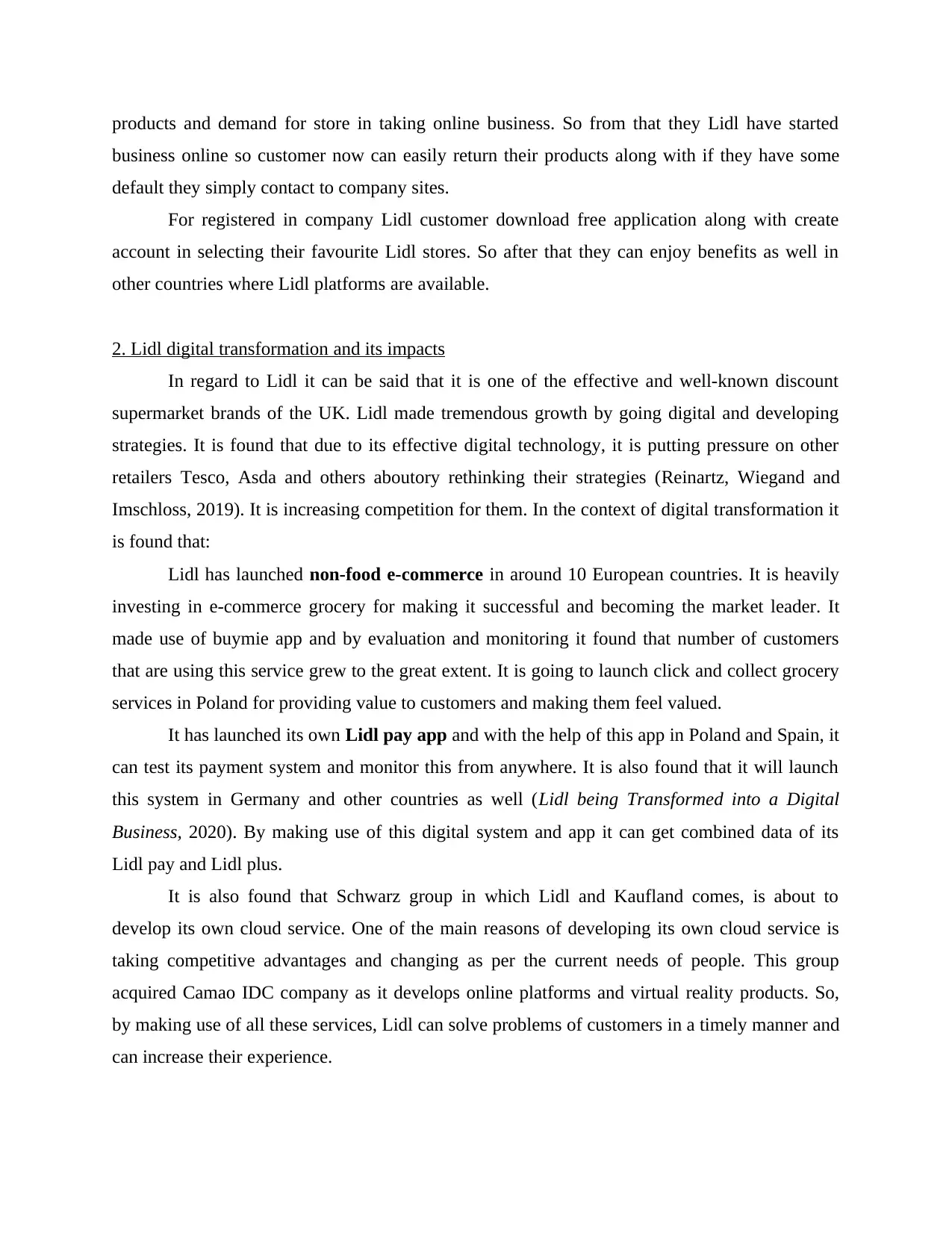
products and demand for store in taking online business. So from that they Lidl have started
business online so customer now can easily return their products along with if they have some
default they simply contact to company sites.
For registered in company Lidl customer download free application along with create
account in selecting their favourite Lidl stores. So after that they can enjoy benefits as well in
other countries where Lidl platforms are available.
2. Lidl digital transformation and its impacts
In regard to Lidl it can be said that it is one of the effective and well-known discount
supermarket brands of the UK. Lidl made tremendous growth by going digital and developing
strategies. It is found that due to its effective digital technology, it is putting pressure on other
retailers Tesco, Asda and others aboutory rethinking their strategies (Reinartz, Wiegand and
Imschloss, 2019). It is increasing competition for them. In the context of digital transformation it
is found that:
Lidl has launched non-food e-commerce in around 10 European countries. It is heavily
investing in e-commerce grocery for making it successful and becoming the market leader. It
made use of buymie app and by evaluation and monitoring it found that number of customers
that are using this service grew to the great extent. It is going to launch click and collect grocery
services in Poland for providing value to customers and making them feel valued.
It has launched its own Lidl pay app and with the help of this app in Poland and Spain, it
can test its payment system and monitor this from anywhere. It is also found that it will launch
this system in Germany and other countries as well (Lidl being Transformed into a Digital
Business, 2020). By making use of this digital system and app it can get combined data of its
Lidl pay and Lidl plus.
It is also found that Schwarz group in which Lidl and Kaufland comes, is about to
develop its own cloud service. One of the main reasons of developing its own cloud service is
taking competitive advantages and changing as per the current needs of people. This group
acquired Camao IDC company as it develops online platforms and virtual reality products. So,
by making use of all these services, Lidl can solve problems of customers in a timely manner and
can increase their experience.
business online so customer now can easily return their products along with if they have some
default they simply contact to company sites.
For registered in company Lidl customer download free application along with create
account in selecting their favourite Lidl stores. So after that they can enjoy benefits as well in
other countries where Lidl platforms are available.
2. Lidl digital transformation and its impacts
In regard to Lidl it can be said that it is one of the effective and well-known discount
supermarket brands of the UK. Lidl made tremendous growth by going digital and developing
strategies. It is found that due to its effective digital technology, it is putting pressure on other
retailers Tesco, Asda and others aboutory rethinking their strategies (Reinartz, Wiegand and
Imschloss, 2019). It is increasing competition for them. In the context of digital transformation it
is found that:
Lidl has launched non-food e-commerce in around 10 European countries. It is heavily
investing in e-commerce grocery for making it successful and becoming the market leader. It
made use of buymie app and by evaluation and monitoring it found that number of customers
that are using this service grew to the great extent. It is going to launch click and collect grocery
services in Poland for providing value to customers and making them feel valued.
It has launched its own Lidl pay app and with the help of this app in Poland and Spain, it
can test its payment system and monitor this from anywhere. It is also found that it will launch
this system in Germany and other countries as well (Lidl being Transformed into a Digital
Business, 2020). By making use of this digital system and app it can get combined data of its
Lidl pay and Lidl plus.
It is also found that Schwarz group in which Lidl and Kaufland comes, is about to
develop its own cloud service. One of the main reasons of developing its own cloud service is
taking competitive advantages and changing as per the current needs of people. This group
acquired Camao IDC company as it develops online platforms and virtual reality products. So,
by making use of all these services, Lidl can solve problems of customers in a timely manner and
can increase their experience.
Paraphrase This Document
Need a fresh take? Get an instant paraphrase of this document with our AI Paraphraser
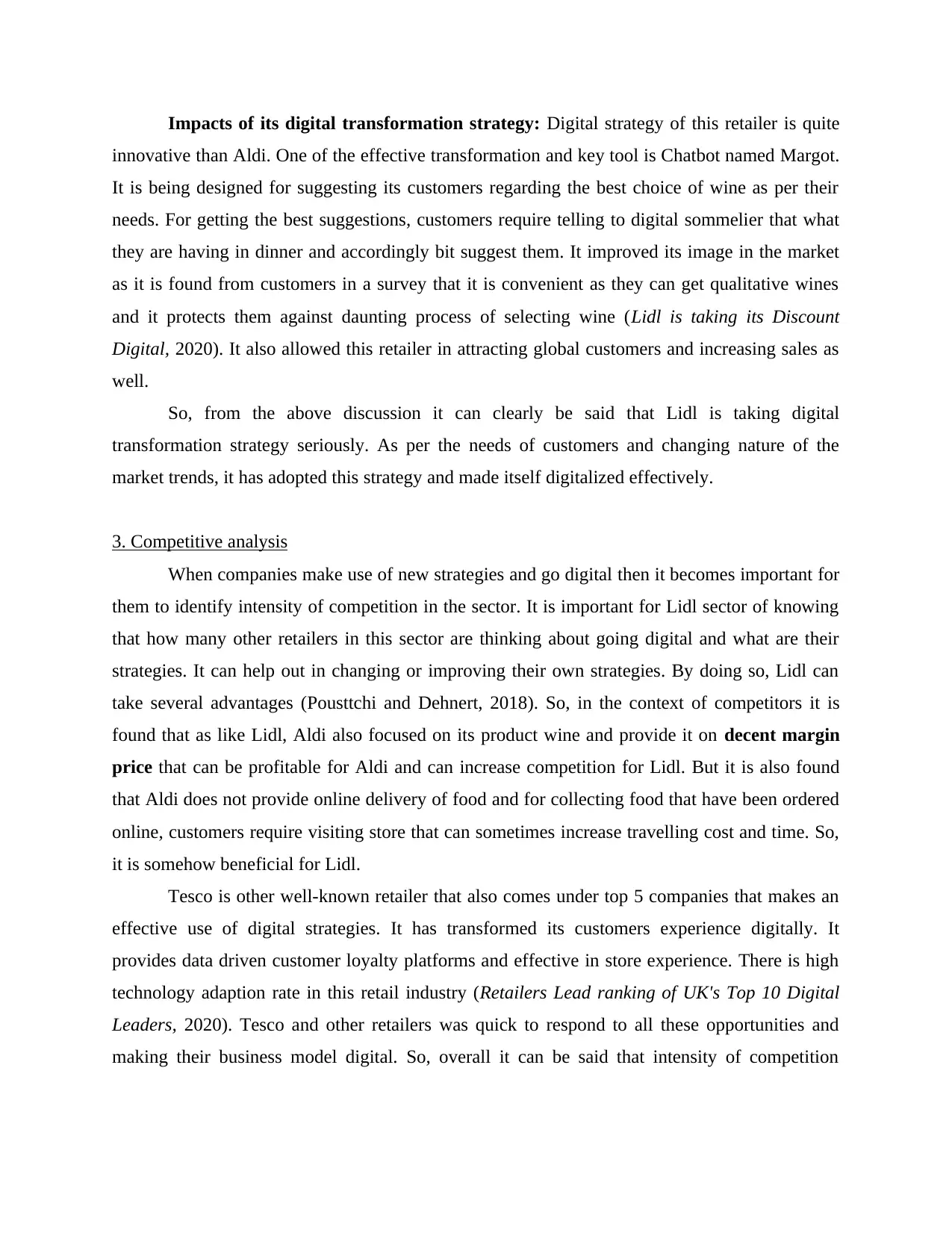
Impacts of its digital transformation strategy: Digital strategy of this retailer is quite
innovative than Aldi. One of the effective transformation and key tool is Chatbot named Margot.
It is being designed for suggesting its customers regarding the best choice of wine as per their
needs. For getting the best suggestions, customers require telling to digital sommelier that what
they are having in dinner and accordingly bit suggest them. It improved its image in the market
as it is found from customers in a survey that it is convenient as they can get qualitative wines
and it protects them against daunting process of selecting wine (Lidl is taking its Discount
Digital, 2020). It also allowed this retailer in attracting global customers and increasing sales as
well.
So, from the above discussion it can clearly be said that Lidl is taking digital
transformation strategy seriously. As per the needs of customers and changing nature of the
market trends, it has adopted this strategy and made itself digitalized effectively.
3. Competitive analysis
When companies make use of new strategies and go digital then it becomes important for
them to identify intensity of competition in the sector. It is important for Lidl sector of knowing
that how many other retailers in this sector are thinking about going digital and what are their
strategies. It can help out in changing or improving their own strategies. By doing so, Lidl can
take several advantages (Pousttchi and Dehnert, 2018). So, in the context of competitors it is
found that as like Lidl, Aldi also focused on its product wine and provide it on decent margin
price that can be profitable for Aldi and can increase competition for Lidl. But it is also found
that Aldi does not provide online delivery of food and for collecting food that have been ordered
online, customers require visiting store that can sometimes increase travelling cost and time. So,
it is somehow beneficial for Lidl.
Tesco is other well-known retailer that also comes under top 5 companies that makes an
effective use of digital strategies. It has transformed its customers experience digitally. It
provides data driven customer loyalty platforms and effective in store experience. There is high
technology adaption rate in this retail industry (Retailers Lead ranking of UK's Top 10 Digital
Leaders, 2020). Tesco and other retailers was quick to respond to all these opportunities and
making their business model digital. So, overall it can be said that intensity of competition
innovative than Aldi. One of the effective transformation and key tool is Chatbot named Margot.
It is being designed for suggesting its customers regarding the best choice of wine as per their
needs. For getting the best suggestions, customers require telling to digital sommelier that what
they are having in dinner and accordingly bit suggest them. It improved its image in the market
as it is found from customers in a survey that it is convenient as they can get qualitative wines
and it protects them against daunting process of selecting wine (Lidl is taking its Discount
Digital, 2020). It also allowed this retailer in attracting global customers and increasing sales as
well.
So, from the above discussion it can clearly be said that Lidl is taking digital
transformation strategy seriously. As per the needs of customers and changing nature of the
market trends, it has adopted this strategy and made itself digitalized effectively.
3. Competitive analysis
When companies make use of new strategies and go digital then it becomes important for
them to identify intensity of competition in the sector. It is important for Lidl sector of knowing
that how many other retailers in this sector are thinking about going digital and what are their
strategies. It can help out in changing or improving their own strategies. By doing so, Lidl can
take several advantages (Pousttchi and Dehnert, 2018). So, in the context of competitors it is
found that as like Lidl, Aldi also focused on its product wine and provide it on decent margin
price that can be profitable for Aldi and can increase competition for Lidl. But it is also found
that Aldi does not provide online delivery of food and for collecting food that have been ordered
online, customers require visiting store that can sometimes increase travelling cost and time. So,
it is somehow beneficial for Lidl.
Tesco is other well-known retailer that also comes under top 5 companies that makes an
effective use of digital strategies. It has transformed its customers experience digitally. It
provides data driven customer loyalty platforms and effective in store experience. There is high
technology adaption rate in this retail industry (Retailers Lead ranking of UK's Top 10 Digital
Leaders, 2020). Tesco and other retailers was quick to respond to all these opportunities and
making their business model digital. So, overall it can be said that intensity of competition
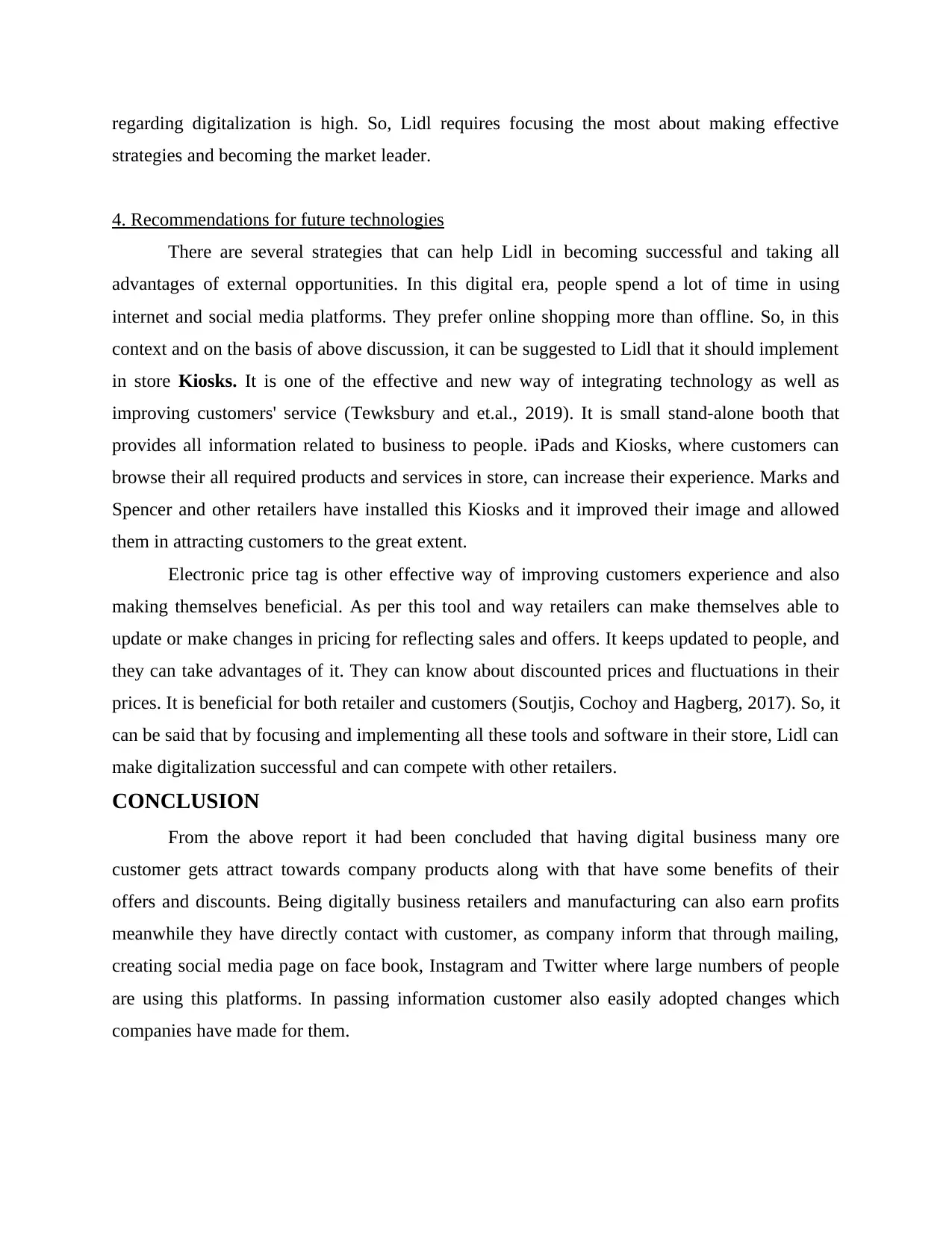
regarding digitalization is high. So, Lidl requires focusing the most about making effective
strategies and becoming the market leader.
4. Recommendations for future technologies
There are several strategies that can help Lidl in becoming successful and taking all
advantages of external opportunities. In this digital era, people spend a lot of time in using
internet and social media platforms. They prefer online shopping more than offline. So, in this
context and on the basis of above discussion, it can be suggested to Lidl that it should implement
in store Kiosks. It is one of the effective and new way of integrating technology as well as
improving customers' service (Tewksbury and et.al., 2019). It is small stand-alone booth that
provides all information related to business to people. iPads and Kiosks, where customers can
browse their all required products and services in store, can increase their experience. Marks and
Spencer and other retailers have installed this Kiosks and it improved their image and allowed
them in attracting customers to the great extent.
Electronic price tag is other effective way of improving customers experience and also
making themselves beneficial. As per this tool and way retailers can make themselves able to
update or make changes in pricing for reflecting sales and offers. It keeps updated to people, and
they can take advantages of it. They can know about discounted prices and fluctuations in their
prices. It is beneficial for both retailer and customers (Soutjis, Cochoy and Hagberg, 2017). So, it
can be said that by focusing and implementing all these tools and software in their store, Lidl can
make digitalization successful and can compete with other retailers.
CONCLUSION
From the above report it had been concluded that having digital business many ore
customer gets attract towards company products along with that have some benefits of their
offers and discounts. Being digitally business retailers and manufacturing can also earn profits
meanwhile they have directly contact with customer, as company inform that through mailing,
creating social media page on face book, Instagram and Twitter where large numbers of people
are using this platforms. In passing information customer also easily adopted changes which
companies have made for them.
strategies and becoming the market leader.
4. Recommendations for future technologies
There are several strategies that can help Lidl in becoming successful and taking all
advantages of external opportunities. In this digital era, people spend a lot of time in using
internet and social media platforms. They prefer online shopping more than offline. So, in this
context and on the basis of above discussion, it can be suggested to Lidl that it should implement
in store Kiosks. It is one of the effective and new way of integrating technology as well as
improving customers' service (Tewksbury and et.al., 2019). It is small stand-alone booth that
provides all information related to business to people. iPads and Kiosks, where customers can
browse their all required products and services in store, can increase their experience. Marks and
Spencer and other retailers have installed this Kiosks and it improved their image and allowed
them in attracting customers to the great extent.
Electronic price tag is other effective way of improving customers experience and also
making themselves beneficial. As per this tool and way retailers can make themselves able to
update or make changes in pricing for reflecting sales and offers. It keeps updated to people, and
they can take advantages of it. They can know about discounted prices and fluctuations in their
prices. It is beneficial for both retailer and customers (Soutjis, Cochoy and Hagberg, 2017). So, it
can be said that by focusing and implementing all these tools and software in their store, Lidl can
make digitalization successful and can compete with other retailers.
CONCLUSION
From the above report it had been concluded that having digital business many ore
customer gets attract towards company products along with that have some benefits of their
offers and discounts. Being digitally business retailers and manufacturing can also earn profits
meanwhile they have directly contact with customer, as company inform that through mailing,
creating social media page on face book, Instagram and Twitter where large numbers of people
are using this platforms. In passing information customer also easily adopted changes which
companies have made for them.
⊘ This is a preview!⊘
Do you want full access?
Subscribe today to unlock all pages.

Trusted by 1+ million students worldwide
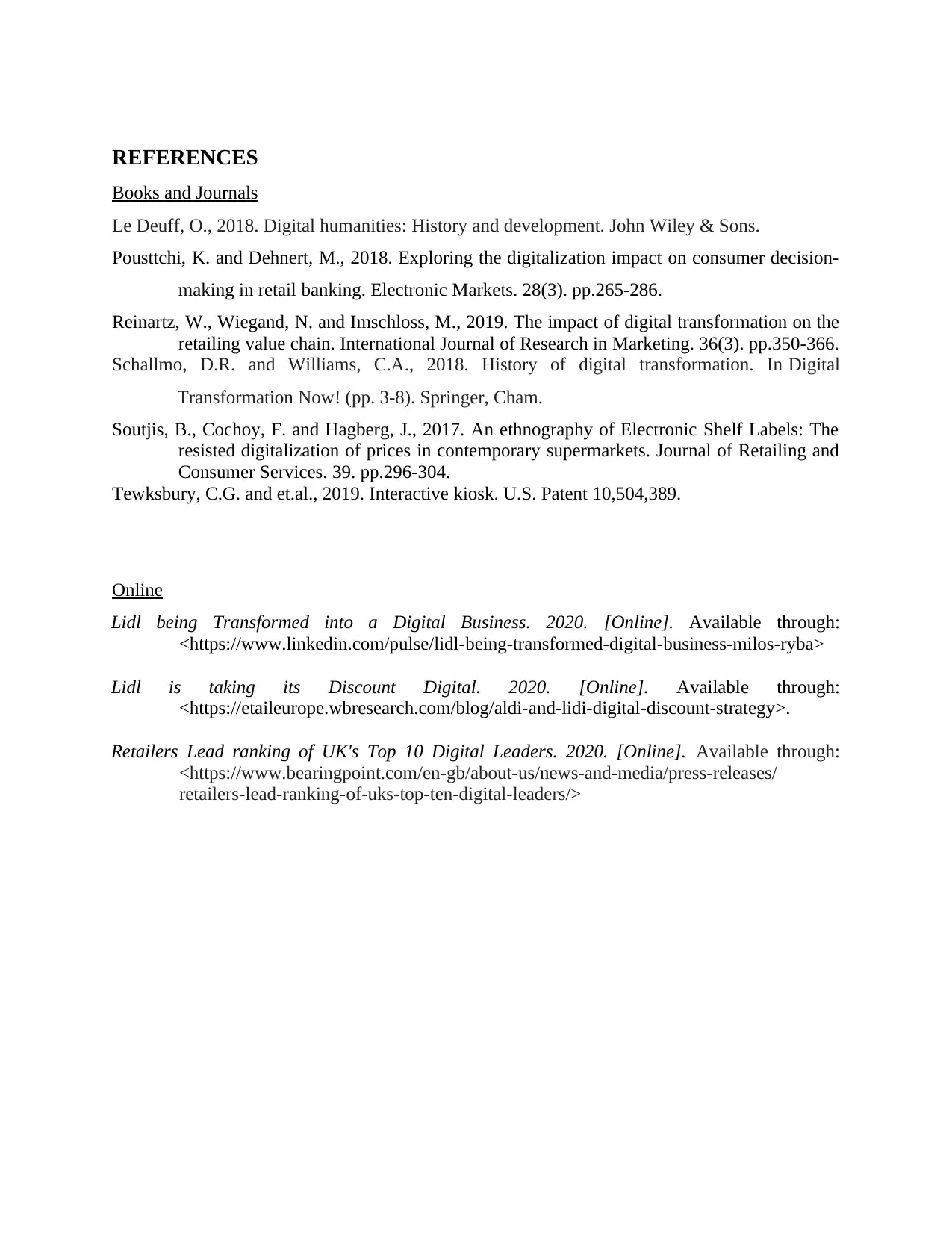
REFERENCES
Books and Journals
Le Deuff, O., 2018. Digital humanities: History and development. John Wiley & Sons.
Pousttchi, K. and Dehnert, M., 2018. Exploring the digitalization impact on consumer decision-
making in retail banking. Electronic Markets. 28(3). pp.265-286.
Reinartz, W., Wiegand, N. and Imschloss, M., 2019. The impact of digital transformation on the
retailing value chain. International Journal of Research in Marketing. 36(3). pp.350-366.
Schallmo, D.R. and Williams, C.A., 2018. History of digital transformation. In Digital
Transformation Now! (pp. 3-8). Springer, Cham.
Soutjis, B., Cochoy, F. and Hagberg, J., 2017. An ethnography of Electronic Shelf Labels: The
resisted digitalization of prices in contemporary supermarkets. Journal of Retailing and
Consumer Services. 39. pp.296-304.
Tewksbury, C.G. and et.al., 2019. Interactive kiosk. U.S. Patent 10,504,389.
Online
Lidl being Transformed into a Digital Business. 2020. [Online]. Available through:
<https://www.linkedin.com/pulse/lidl-being-transformed-digital-business-milos-ryba>
Lidl is taking its Discount Digital. 2020. [Online]. Available through:
<https://etaileurope.wbresearch.com/blog/aldi-and-lidi-digital-discount-strategy>.
Retailers Lead ranking of UK's Top 10 Digital Leaders. 2020. [Online]. Available through:
<https://www.bearingpoint.com/en-gb/about-us/news-and-media/press-releases/
retailers-lead-ranking-of-uks-top-ten-digital-leaders/>
Books and Journals
Le Deuff, O., 2018. Digital humanities: History and development. John Wiley & Sons.
Pousttchi, K. and Dehnert, M., 2018. Exploring the digitalization impact on consumer decision-
making in retail banking. Electronic Markets. 28(3). pp.265-286.
Reinartz, W., Wiegand, N. and Imschloss, M., 2019. The impact of digital transformation on the
retailing value chain. International Journal of Research in Marketing. 36(3). pp.350-366.
Schallmo, D.R. and Williams, C.A., 2018. History of digital transformation. In Digital
Transformation Now! (pp. 3-8). Springer, Cham.
Soutjis, B., Cochoy, F. and Hagberg, J., 2017. An ethnography of Electronic Shelf Labels: The
resisted digitalization of prices in contemporary supermarkets. Journal of Retailing and
Consumer Services. 39. pp.296-304.
Tewksbury, C.G. and et.al., 2019. Interactive kiosk. U.S. Patent 10,504,389.
Online
Lidl being Transformed into a Digital Business. 2020. [Online]. Available through:
<https://www.linkedin.com/pulse/lidl-being-transformed-digital-business-milos-ryba>
Lidl is taking its Discount Digital. 2020. [Online]. Available through:
<https://etaileurope.wbresearch.com/blog/aldi-and-lidi-digital-discount-strategy>.
Retailers Lead ranking of UK's Top 10 Digital Leaders. 2020. [Online]. Available through:
<https://www.bearingpoint.com/en-gb/about-us/news-and-media/press-releases/
retailers-lead-ranking-of-uks-top-ten-digital-leaders/>
1 out of 7
Related Documents
Your All-in-One AI-Powered Toolkit for Academic Success.
+13062052269
info@desklib.com
Available 24*7 on WhatsApp / Email
![[object Object]](/_next/static/media/star-bottom.7253800d.svg)
Unlock your academic potential
Copyright © 2020–2025 A2Z Services. All Rights Reserved. Developed and managed by ZUCOL.





